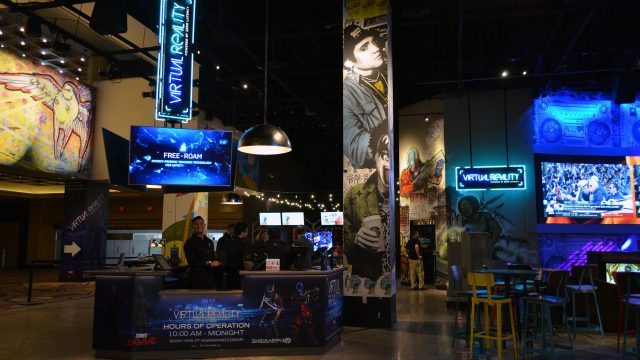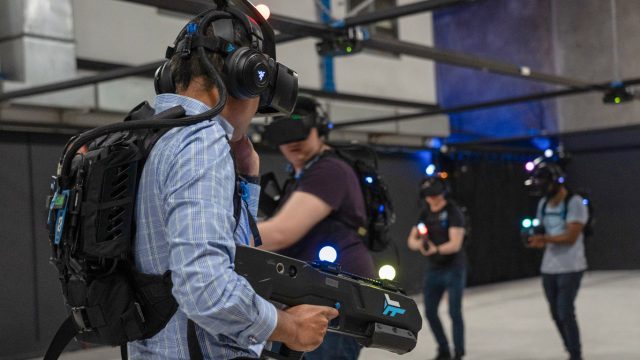Zero Latency is an Australia-based creator of a VR attraction platform and content. Since its founding in 2013, the company has launched five co-op VR games supporting up to eight players. The company’s latest game, Sol Raiders, is the first to pit players against each other in a 4 vs. 4 format. Road to VR got to preview the new title and see how Zero Latency is tackling the unexpected challenges that come with PVP at a VR attraction.
With 25 locations now in operation around the globe, Zero Latency is one of the leading VR attraction platforms today. The company develops the hardware, software, and content for the platform, which allows up to eight users to simultaneously play a shared virtual reality experience which unfolds in a large physical playspace that’s 60 × 30 ft (~18.3 × 9 m).
Zero Latency claims impressive growth over the last three years, culminating in 300,000 unique players and 420,000 unique plays in 2018 alone. At roughly $50 USD per play (with regional variances), the company’s platform appears to be generating tens of millions in revenue annually.
With three years of operation under their belt, the company is forging ahead with a new challenge: bringing competitive PVP gameplay to their platform. While the current roster includes five titles spanning co-op shooters and family-friendly fantasy explorations, the newest addition, Sol Raiders, will put players in direct competition with each other in a 4 vs. 4 format.
But building something that actually feels competitive is just the first of many challenges which come with pitting players against each other in a free-roaming VR platform. To learn more about Zero Latency’s approach to Sol Raiders. I visited the company’s Las Vegas location at the MGM Grand hotel and casino to preview the game first-hand.
Stepping into Zero Latency


The MGM location has been open since 2017; it’s located inside the venue’s ‘Level Up’ lounge which caters to a millennial crowd through traditional arcade machines, pool, beer pong, and now VR. Neon ‘Virtual Reality’ signs draw patrons to the Zero Latency kiosk where players trade $50 for 30 minutes of gameplay, choosing between any of the five available titles (soon to be six with Sol Raiders).
After entering some info on a desk-mounted iPad, players are ushered through a small corner door that leads to a small room where they are pre-briefed on their chosen game, then fitted with hardware. The Zero Latency hardware consists of backpack-mounted computers, customized OSVR headsets, headphones, and pump-action gun peripherals. The headsets and guns are dotted with glowing orbs which are used to track players and their weapons.
Once everyone is suited up, players are led into the next room, an unassuming space with black floors, walls, and ceilings, with little more than some extra equipment hanging on the wall and a white grid on the floor. A veritable void it may be, but this of course is where the magic happens.
Once inside, players are instructed to put on their headsets and headphones, and find themselves in futuristic glowing pre-game lobby where usernames entered earlier at the kiosk float about eight pillars of light. Users are asked by a ‘game-master’ (who is overviewing the game and can speak to players over their headphones) to step into the pillar which corresponds with their name, allowing the platform to uniquely identify all players and collect data on their gameplay for a post-game breakdown.
A similar approach is used to break up the eight players into two teams of four; after the name assignment, blue and orange pillars appear on opposite sides of the playspace, and stepping inside designates your team affiliation.
From here, players are transported with their teammates to a brief training space where they learn how to use their multi-purpose weapons: pulling the trigger works like a semi-auto laser rifle (which can overheat with too much use), while pumping the action readies a ‘charged’ spread shot which works like a shotgun. The multi-purpose weapon is a smart design choice which offers weapon variety without needing to implement a true weapon management system (thereby keeping the experience streamlined and accessible).
After a minute or so of learning how to shoot the weapons, players are dropped into the first of three unique objective-based maps, a symmetrical arena consisting of corridors toward either end of the stage, with a somewhat open space in the middle. Above that middle open space is a floating orb which acts as a push/pull style objective; players aim their weapons at the orb and hold their triggers to push the orb toward the opposing side. A point is scored once the orb is moved far enough to the other side, and it is then reset to the middle.
Players start at either end of the map and quickly engage each other, exchanging volleys of fire while trying their best to hide around corners and cover exposed angles. Once you take enough damage you’ll die and need to respawn back at your starting point, but therein lies a major challenge which Zero Latency has solved with a very clever system.


